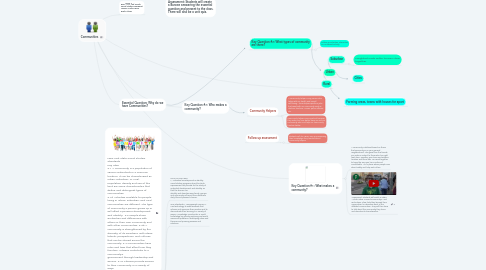Communities
by Margaret Liguori

1. Key Question #3: Who makes a community?
2. Key Question #1: What makes a community?
2.1. A community is defined based on those that surround you in your general neighborhood. This goes from the friends you make in school to those who live right next door. Together you share similarities in location and social ties. You work together to keep the area you live in safe and comfortable. "It's a place where people care about safety and help each other."
2.2. Assessment: Students will watch a video, "What Makes a Good Community?" and write down a few facts they learned from Casey when he describes each of the different communities. They will then have to talk about the community they live in and describe its characteristics.
3. Rural
4. Key Question #2: What types of community are there?
4.1. Follow up activities: interactive SMARTboard activity
5. Farming areas, towns with houses far apart
6. Cities
7. EDU 5230 2nd Grade Social Studies Margaret Liguori Andrea Ross Emily Klivan
8. Essential Question: Why do we have Communities?
9. New York State Social Studies Standards Key Idea: 2.1 A community is a population of various individuals in a common location. It can be characterized as urban, suburban, or rural. Population density and use of the land are some characteristics that define and distinguish types of communities. 2.1d Activities available for people living in urban, suburban, and rural communities are different. The type of community a person grows up in will affect a person’s development and identity. 2.2 People share similarities and differences with others in their own community and with other communities. 2.2b A community is strengthened by the diversity of its members, with ideas, talents, perspectives, and cultures that can be shared across the community. 2.4 Communities have rules and laws that affect how they function. Citizens contribute to a community’s government through leadership and service. 2.4c Citizens provide service to their community in a variety of ways.
9.1. NCSS STANDARDS IV. Individual Development & Identity: Social studies programs should include experiences that provide for the study of individual development and identity, so that the learner can: Identify and describe ways family, groups, and community influence the individual’s daily life and personal choices.
9.2. ISTE Standards 1. Empowered Learner C. Use technology to seek feedback that informs and improves their practice and to demonstrate their learning in a variety of ways 3. Knowledge Constructor D. Build knowledge by actively exploring real-world issues and problems, developing ideas and theories and pursuing answers and solutions.
10. Suburban
10.1. Neighborhoods withe houses close together
11. Urban
12. Community Helpers
12.1. A community helper is any person who helps with our health and overall well-being. These helpers perform jobs that assist with our community such as doctors, teachers, nurses. police officers, etc.
12.2. Community helpers are important because they make our lives better, keep us and our community safe, and help our community function better.
13. Assessment: Students will create a Buncee answering the essential question and present to the class. There will also be a unit quiz.
14. Follow up assessment
14.1. students will do a Brain Pop quiz assessing their knowledge they learned about community helpers


